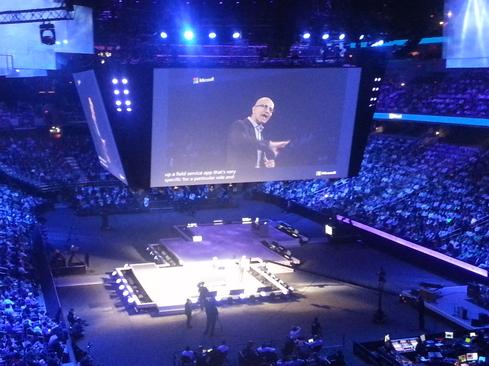Microsoft's Nadella: Productivity Is Our Soul
Microsoft CEO Satya Nadella promises Worldwide Partner Conference audience that productivity tools will top the company's priorities in the age of mobile and cloud.


Cloud Contracts: 8 Questions To Ask
Cloud Contracts: 8 Questions To Ask (Click image for larger view and slideshow.)
When setting priorities, Microsoft CEO Satya Nadella says there is no breaking the tie between mobile-first and cloud-first as strategies for the next generation of computing. But beyond that, the company needs to make choices.
"The real question that needs to be asked -- as well as answered -- is what [can we] do as an ecosystem that's unique, that's impactful," Nadella told the crowd at Microsoft's Worldwide Partner Conference in Washington, D.C. "To me, the answer is clear." Creating productivity tools is the thing Microsoft is best known for, he said, and the thing that stretches beyond the Windows PC.
"That's our singular mission, that's what's unique to us, that's what in our core and in our soul -- and that's what we're going to do." As computing power keeps growing, he added, what's scarce is human attention and time.
[For more on Microsoft's cloud focus, see Microsoft Pushes Partners To Cloud.]
Cloud and mobile demand equal attention because mobile productivity depends so much on cloud services and contextual data, Nadella said. This is a source of frustration to computer engineers who don't like having two things ranked #1, he noted, but the sorting algorithm doesn't work. What's more important, he continued, is paying attention to the demands from users about data and privacy and being in control of how cloud and mobile tools behave. "We want Windows to stand for that user-controlled privacy."
To maintain its reputation for productivity, Microsoft will focus on innovating around new modes of input and output that work on phones as well as PCs and are generally more flexible. Nadella said he already finds himself talking to his Windows PC phone "more than I have ever talked to Windows." One onstage demo showcased the latest generation of Microsoft's Cortana voice-powered digital assistant, which is capable of translating a phrase like "add an appointment for Thursday at 8 pm and call it dinner with my wife" into an appointment -- and warning about another event scheduled at the same time.
The biggest crowd-pleaser of the event was a voice translation demonstration of a Skype session between an English speaker, Microsoft's Steve Clayton, and a German woman -- who was naturally gloating over Germany's World Cup win. As each spoke in their own language, translations appeared a moment later, as on-screen subtitles accompanied by a synthesized voice in the other language. Aside from a minor grammatical glitch ("Well how is it me friends"), the German speaker was able to express herself quite clearly ("I could not be happier I celebrated the whole night") and even tease Clayton, who is British ("In a single game, Germany has scored more goals than England in the last two events together."). Microsoft is targeting beta release for the feature later this year.
Skype Translate - awesome verbal translation service coming later this year #WPC14 pic.twitter.com/rCSNhrWYsG
— Darren Spence (@4eyedSalesGuy) July 16, 2014Nadella also showed off a preview of Delve, a recently announced "Office graph" feature that provides a Facebook-like feed of all the activity from across all the productivity applications in a workplace -- for example, allowing you to see that a file has been shared without searching for it in a shared drive or cloud repository. Unlike social sharing in Yammer,
another Microsoft product, the Delve feed would be passively generated in the background. As an alternative to search as a mode of finding information, Delve is a way of tapping the "ambient intelligence" of a workplace.
"Still, search starts with the assumption that you know what you're looking for," Nadella explained.
Reacting to continued complaints that the company is emphasizing mobile to the detriment of desktop users, Microsoft showed how Windows 8.1 adds features that cater to keyboard-and-mouse interaction. While the event did not feature a demo of Windows 9, one of the speakers who preceded Nadella, VP of Windows marketing Tony Profit, flashed up a screen shot of the Start Menu that will reappear in the next version of the desktop operating system, which he promised will be "like the old one but better," with integration for Live Tiles and Modern apps. In the next incarnation, Windows apps will be capable of being tiled or layered side-by-side with traditional Windows applications.
Figure 1:  Microsoft CEO Satya Nadella at the Worldwide Partner Conference 2014
Microsoft CEO Satya Nadella at the Worldwide Partner Conference 2014
For big data and Internet of Things, Nadella showed an application created for ThysenKrupp AG, a global elevator maker, that can track the maintenance status of all the elevators in operation across a site or a region, warn when they need attention, and begin to predict how frequently they should be scheduled for maintenance in the future. The sample app, which visualized elevator operations across the Seattle Seahawks' Virginia Mason Athletic Center, displayed the data visually on a map of the complex, tapping machine learning algorithms running in the Azure cloud. A related demo showed how to build an application to make use of cloud data using the Project Siena rapid application development tool Microsoft has in beta.
"This is not about building things with a RAD tool -- it's about enabling the entire organization to build applications on the edge using those APIs," Nadella said. Partners should also start thinking about what they could build using those kind of resources, he added.
Because this was a partner event, Nadella and his team also spent a lot of time assuring conference attendees that this strategy will prove productive and profitable for them. Nadella told the partners that they energize him. "That's the inspiration, that's the confidence with which we move forward to this mobile-first, cloud-first world," he said.
You're mistaken if you think you can execute in the cloud without using software to orchestrate application life cycles. Here are four reasons why you must. Get the new Cloud Automation Tech Digest today. (Free registration required.)
About the Author(s)
You May Also Like
How to Amplify DevOps with DevSecOps
May 22, 2024Generative AI: Use Cases and Risks in 2024
May 29, 2024Smart Service Management
June 4, 2024







